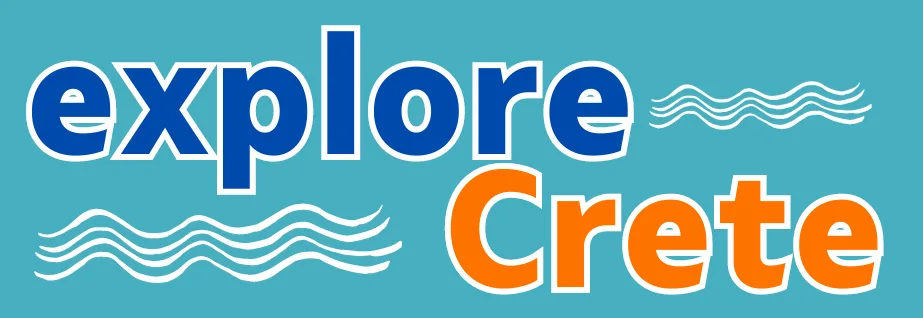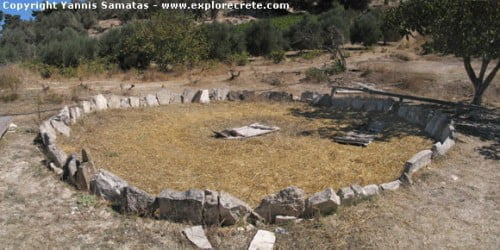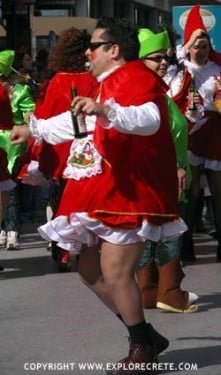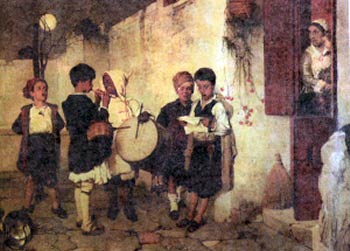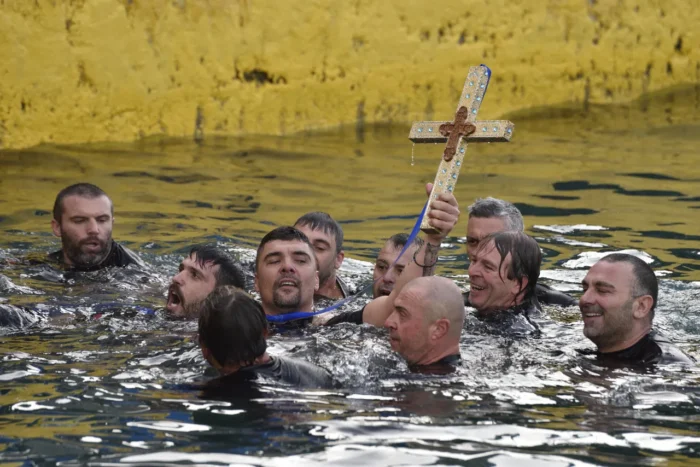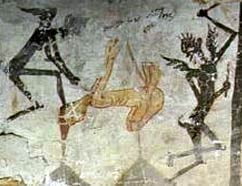Discover Prases and its Chestnut Festival
The village of Prases in Crete
Located in the heart of Crete, 30 kilometres south of the city of Chania, Prases is a small Cretan village with stone-built houses and charming narrow streets.
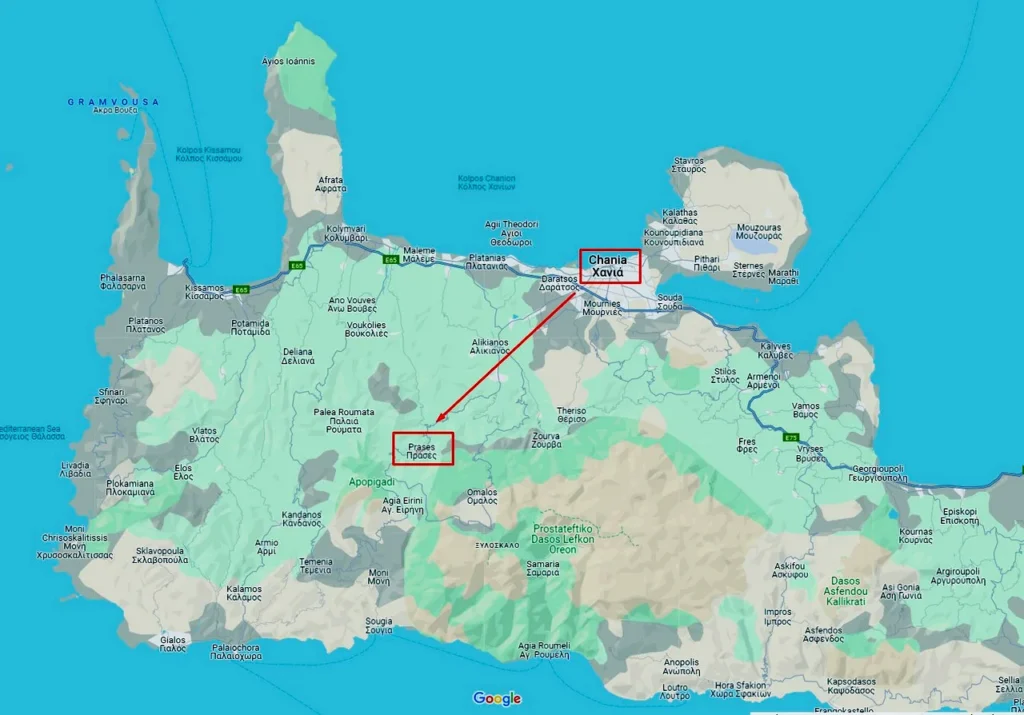
The countryside surrounding Prases is a verdant paradise of chestnut and olive groves, interspersed with fur trees, creating a serene and picturesque setting.
Before entering the village, the breathtaking Prasiano Gorge, with its steep cliffs and lush greenery, offers a unique view. It’s perfect for nature enthusiasts, providing a stunning 5 km walk.
The houses in Prases are widely dispersed. In the central square, you’ll find cafes that also offer meals. On the other side of the village, a small river meanders through Prases, bordered by towering trees. An ancient stone watermill stands beside this river.
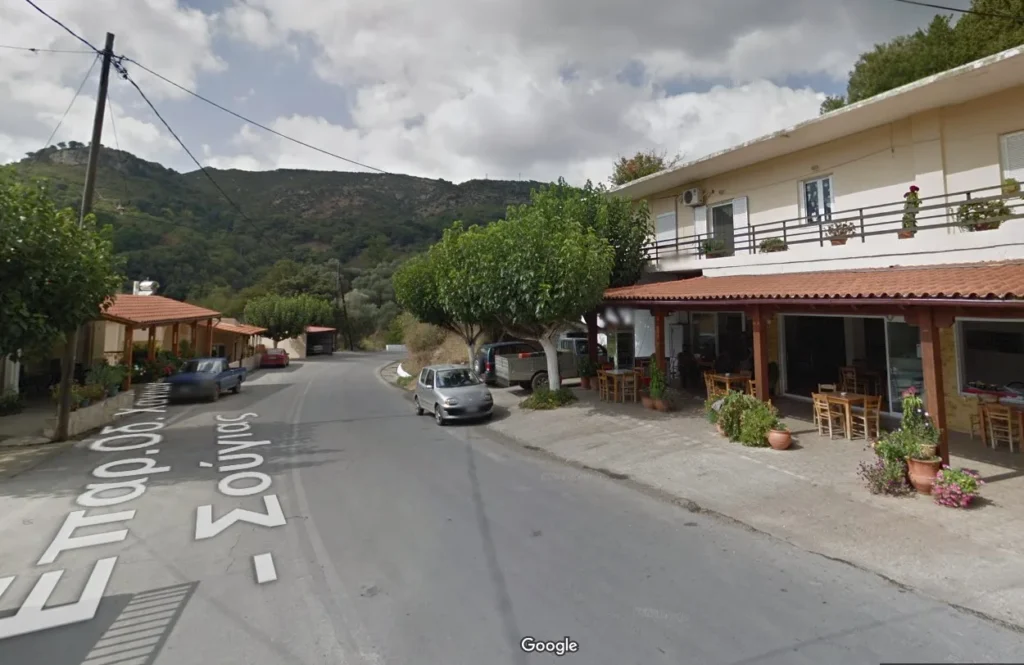
The village’s cafes and taverns, along with the main settlement, are situated on the central road, showcasing the new face of Prasé. However, the old settlement still stands, its remnants visible and stretching parallel to the river below the main road. A walk through this historic part reveals delightful surprises, from the beautiful, green natural scenery to the hidden gems like the “Askidia” settlement with its magnificent pine forest, which produces high-quality honey.
The Byzantine church of Saint Nicholas, dating back to the 15th century and adorned with impressive frescoes, is a must-visit. This church, once a secret school during Ottoman rule, adds to the village’s refreshing oasis where time seems to stand still amid its natural beauty.
The Chestnut Festival of Prases
Prases’ inhabitants primarily produce chestnuts and olive oil. Each October, the Chestnut Festival, hosted by the village’s Cultural Association, showcases traditional Cretan cuisine and a variety of chestnuts prepared in seven unique ways.
Chosti and Vasiliki Strata: Hidden Treasures
The local community of Prasé also encompasses the “Chosti” settlement, now sparsely populated but known for its stunning natural beauty and hidden amidst lush vegetation. Another highlight is the “Vasiliki Strata,” an ancient path that once connected Prasé to the Municipality of Kantanos-Selino. This historic route, once traveled by horseback over three hours, now offers a unique hiking experience through breathtaking scenery.
Explore Nearby Attractions
Don’t miss other attractions in the area, including Omalos, Zourva, Psathogiannos, Fournes, Skinés, Sembronas, Orthouni, Mesklá, Lakoi, Koufos, Karanou, Vatolakkos, and Alikianos. Discover these hidden gems before your next adventure.
The entrance to the gorge of Agia Eirini is 13 km south of Prases.
An unexpected visit to Prases Village in Chania
By Lars Magnusson
It is the 28th of October the date when in 1940 General Metaxas rejected the ultimatum by which Italy demanded the right to occupy Greece. The Ohi-day (ohi=no) is celebrated all over the country and in Chania there will be a big parade.
As we watched this parade last year, we have instead decided to attend the chestnut festival in the village of Prases. We have passed there many times and some of you may recall this from my Omalos story. We were then a little uncertain about the road:
“About 200 metres in front of us are 3 men, all dressed in black, discussing something; it is easy to tell from all their gestures. I drive towards them.
“Are you crazy, we have a lot money, two cameras and one binocular and look at those men. Don’t you understand they will rob us?”
“Ok, they look a little wild but these men are mountainmen and they are supposed to look like that.”
Sofia is acting very fast and in seconds everything is hidden. Two young men and one old are coming towards the jeep, window up on one side but down on my side. I try to ask about the road to Prases and there is immediately a huge smile on the old man’s face.
He is willing to show us the way and in seconds he is in the backseat. “Pame!” (lets go!) We are now driving down the hill and the road is very, very bad and kind of soft. I can feel the right-side wheels sinking in the mud. This is good, very good!!!
My co-driver has changed into a pale-face whispering: “He just want us to take him home. Then he will leave us to ourselves and we will never find our way back”
From behind we hear the man saying: “Apo pou eisai?” (Where are you from?)
The silence is broken and we have now reached the bottom of a valley and it is very nice down here. Everything is green and yellow-coloured flowers cover many of the bushes. Some of the trees, maybe fruit-trees, are dressed in white flowers. A brook, which we have to cross a couple of times, is running along the road.
There are also gates to open and Sofia is doing a great job and our passenger in the back is smiling and happy. Of course it was a happy ending to this story. A big hug and a kiss from Sofia and we leave him happy together with his friends.
The road to Prase is very nice and the views over the mountains and the gorge down under are beautiful. When we arrive to the village about 10.30 in the morning the activity is already very high. People are running to and fro. We leave the Volvo and join the villagers.
In the centre of the village the road is turning into a “market” with three houses and one kafenion on one side and two houses and a combined taverna/kafenion on the other side.
Trees also frame the “market” and in the background we can see the mountain-slopes also covered by trees and bushes.
Here and there in the green landscape there are small white houses and also some dirt roads leading up towards Omalos. We for sure know one of them.
The sky above is blue and a smooth, warm wind is coming from south. On our left side, from the front of the kafenion, tables and chairs in white plastic are placed and formed like a big fan. On the other side the tables and the chairs are placed along the road. There is still plenty of space though for cars and even for the early morning-bus to pass through.
Further down the road on the right side is a little white village church, today decorated with flowers. From a small hill behind the “market” we have a perfect view of it all. Not many guests yet but it’s still early. We are forced back down to the “market” again by a teasing smell.
In front of the house next to the taverna food is prepared. Hugh casseroles with lamb and katsika are put over open fire and the cooks, three men using gaily coloured aprons, are watching over it very closely.
They say skimming is very important and of course they are right. Herbs? No, just salt that’s all.

On the ground, waiting for being brought inside, there are some beer cases filled with meat from the first casseroles to be ready. To our joy one of the cooks say: “Oriste parakalo!”
We grab one piece each and everybody around seems to be looking at us with big question marks written in their faces.
Silence for a short moment.
“Endaksi?” they asked and we replied: “To vrasto einai poli, poli nostimo. Bravo! Mas aresi poli!”
What could be more wrong here than to say: “Too many cooks spoil the broth”. Skimming is very important. Filled up beer cases

There are also some big pots with chestnuts in boiling water looked after by an old woman dressed in black. When I take a picture of her, she is smiling towards me in a warm and a very kind way. It is so easy to love this people and it is truly an honest to get to know them and to be a part of their charm, hospitality and friendship.
“Ela, ela apo edo sto fourno”. A young strong-looking woman is waving to us to come and take some photos. Behind the casseroles is an oven in which she is roasting chestnuts. They are black and very hot but they taste very nice.
“Ela mesa”. She is dragging Sofia and me inside the house, where on some tables there are chestnuts made in different ways; boiled, roasted, honey-dipped, chocolate-covered and many more. She tells us to taste all the different kinds and they are nice, especially the one with chocolate. There are also plenty of bottles all over filled with tsikoudia and local wine. It is easy to tell that this will be good party.
I leave the ladies and the nuts, sorry chestnuts, behind. Opposite from the taverna another teasing smell is mixing in the air. The curling smoke is telling me that there is a grill somewhere over there. I cannot see it because it’s situated down below.
Crossing the road, I notice that cars are being parked on both sides all the way down to the church. Dressed up people, old and young are now joining the festival and soon the “market” will be crowded.
At the entrances to the “market” there are two men selling tickets to the fabulous price of only 3.500 drachmas (10 euros). The masters of the brizoles are working in the heat from the grill in a high tempo. They are turning the meat over and over again only using their hands.
At the same moment as I am zooming them in with my camera, my right eye register the sign from one of the masters and I hear “Ela”. I am joining them and a big brizola and a glass of wine is presented to me. Heaven is close.
They tell me, that this is the third year the village is organising a party like this to celebrate the chestnuts and it is the first time outdoors. “My friend, you have brought good weather”, they say in one voice. “Have I”? Yes of course I have.
Next to us are some eight or ten barrels spreading that special smell of mash. In a couple of days it will be first class tsikoudia. Maybe it would be a good idea to return by then. After a superb brizola, two glasses of a wine and to finish our private mini barbecue party, a glass of one of the best tsikoudia I have ever tasted, I will now try to find Sofia again.
The meat, to vrasto, on the other side is now ready and the men are straining the broth, which is going to be used for pilafi. Young boys are putting chestnuts, salads and bottles, both wine and tsikoudia, on the tables. Everywhere I hear the famous and well-known words “Yamas” or “Si gia”.
The fan has changed from white into a mixture of red, blue, green, yellow, brown, black, and pink and so on in the most beautiful way. People are dressed in all colours and this has given life to the fan and it is moving and changing all the time. The party is on.
But where is Sofia? I am looking around and soon I find her in a big company eating, drinking and laughing. She has met a good friend of ours Nikos, the cook from Taverna Moutoupaki, and his company. She is in good hands so I continue to explore what is happening with the food.
The pilaffi is made inside the “chestnut-house” and the cook in charge stir rice and broth together with a wooden ladle. The critical moment, when to stop, in order to have a perfect pilaffi does not seem to bother him at all because his wife is now supporting him. She is the specialist in the village.
From outside we hear musicians tuning their instruments, the lira and the lute.

After a few minutes the pilaffi is ready and now everything is happening very fast. Boys and girls are running in high speed out to the tables with dishes filled with meat and pilaffi and from the other side of the road brizoles are brought out in the same way. The young boys in the orchestra start to play.
What a perfect timing! The pilaffi is ready to be served
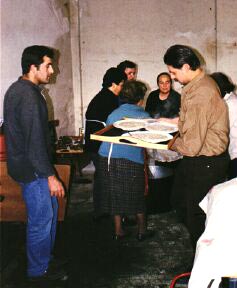
I return to Sofia and join her and her company. Good and much food, wine and chestnuts, good and bad stories and a lot of laughter in the company of friendly and nice people, what more can we ask for. After too much food we need to move a little and therefore we take a walk along the road.
Cars are parked everywhere and the evening-bus is stuck in a bend. The driver is trying over and over again but it is impossible for him to pass. A couple of passengers jump out from the bus and the rest is very simple. They lift two of the cars into a ditch and the road is free. The car-drivers will for sure wonder; did I really park my car that bad? I sincerely hope that is was the man in the family parking the car otherwise…
The hours are passing fast and soon it is getting dark. Above the mountains the man in the moon is looking down at the people and the good food. It is new moon so he looks kind of hungry. I invite him to the party: “My friend, how about a brizola and some pilaffi?”
“Yes wow, that would be very nice, thank you. As you can see I am starved”
What a happening that would be. From a new moon to a full moon in one night. In each end of the “market” fires are lit by a couple of women while others are making a short cut with a knife in the chestnuts before they, after a while, are put onto the live coal to be roasted.
Children are running around, playing and screaming of joy and happiness. In front of the fan young men are dancing and singing to the traditional music accompanied by people clapping their hands. “Opa! Opa!”
We can almost touch the atmosphere; it is one of those magical nights. Unfortunately there is an end to everything and we have to go back to Chania but… who is that man over there, yes, the man with the grey hair, the moustache and a big smile on his face? He looks very familiar. I am sure; he is the “robber”, whom we brought back from Omalos about six or seven years ago. Shall we or shall we not make us know to him? Will he or is it possible for him to remember us?
We decide to leave him and his company behind. Maybe we can come back some other time and look him up (as a matter of fact we did but that will be another story). It is late when we arrive back to Chania. It is impossible to sleep. When I am closing my eyes, the impressions from the village and its people are running like a movie and I am back in Prases again. Next to me in her bed Sofia is dancing the night away and I am sure she also is back in the village. Late at night we have to leave Prases. It has been a magic day and night in Crete…again.
Kriti stis kardies mas
Crete in our hearts!
Lars and Sofia Magnusson
Sweden
** Do you have a personal story that you want to share with us? Email it to explorecrete
© explorecrete.com All Rights Reserved. Reproduction or copying without permission is prohibited.
